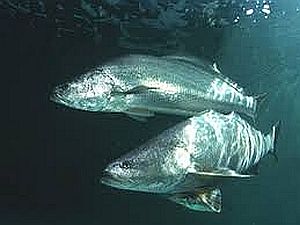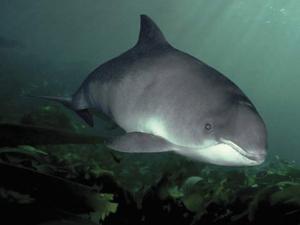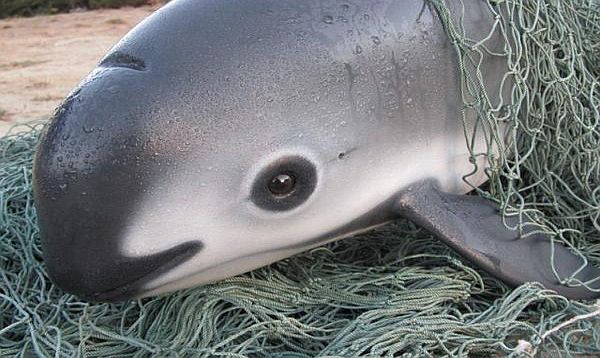Baja California, Mexico - In recent decades, the sleek, wide-eyed vaquita porpoise has been pushed to the brink of extinction by poachers pursuing another critically endangered sea creature, the totoaba, a fish whose swim bladder sells on the Chinese black market for thousands of dollars. The porpoises end up caught in nets intended for the totoaba and killed as collateral damage.
The vaquita (its name is Spanish for "little cow") is a toothed whale and the smallest of all cetaceans; a full-grown female can measure just five feet and weigh only 75 pounds. Thousands of vaquitas once plowed the Sea of Cortez, also known as the Gulf of California, which is bordered on the east by the Mexican mainland and on the west by the Baja California peninsula. Today, their numbers are estimated at around 10 but no more than 22 in the wild.
 |
There is little time left to act to save the vaquita, yet there is hope. For Mexico's new president, Andrés Manuel López Obrador, the fate of the little porpoise represents political opportunity and the chance of failure. He can do nothing and preside over the first sea mammal extinction in North America in decades. Or he can save one of Mexico's national symbols and rescue a troubled fishing industry.
"This is doable even now," said Brooke Bessesen, a conservationist and author of a new book, Vaquita: Science Politics and Crime in the Sea of Cortez. "We have to come up with solutions that buy time. This is not a numbers game. It's a game of time."
The Sea of Cortez is 62,000 square miles of azure and turquoise water that ranks as one of the most productive fisheries in the world, with more than 900 species of fin fish, including blue marlin and whale sharks. Commercial fishing started in earnest in the 1940s and is largely concentrated off the Mexican state of Sonora, on the eastern shore of the sea. But poachers are generally thought to be the problem these days.
The small-scale fishermen who live on the sea's western and northern shores motor out in cheap fiberglass skiffs known as pangas, armed with gillnets. These nets, made from near invisible nylon mono- and multi-filament, float on or near the surface and are weighted at the bottom. They kill indiscriminately, entangling everything from sea lion pups to great white sharks. Today, there are so many abandoned nets that the Mexican government pays fishermen to drag them ashore.
 |
Last April, Mexican authorities stopped a Chinese man at the Mexico City International Airport with 355 totoaba swim bladders. Three days later, another Chinese man bound for China had 417 swim bladders in two suitcases. And in December, Chinese officials confiscated 980 pounds of swim bladders, estimated to be worth $26 million. Sixteen people were arrested.
So it is no wonder that poachers and their gillnets have pushed the totoaba onto the list of critically endangered species maintained by the International Union for Conservation of Nature, and dragged the even more endangered vaquita along with it. The tiny porpoises drown when they are snagged in these nets.
The Mexican government shares some of the blame. Warnings that the vaquita might vanish arose years ago when there were still hundreds in the wild, but it failed to take effective actions to protect them. Mr. López Obrador's predecessor, Enrique Peña Nieto, banned the use of gill nets in the porpoise's habitat in 2015, for instance, but not their possession.
An attempt to capture porpoises to breed them in captivity in 2017 led to one dying; another nearly did and had to be released. The totoaba, however, is being bred in captivity, giving the species a path to survival. But that effort is likely to be counterproductive for the vaquita, because it will only encourage more poaching of the totoaba.
The vaquita's situation is so dire that Thomas A. Jefferson, a San Diego marine biologist and conservationist, said he feared that extinction was its most likely fate. "The conservationist in me doesn't want to admit that but the biologist has to," he said.
 |
The vaquita was never widely distributed, numbering perhaps only 5,000 at its modern height and located only in the Sea of Cortez. But there is no evidence that it has hit the bottleneck of birth defects from inbreeding often seen in declining populations.
And so, there is hope - if President López Obrador acts swiftly. The vaquita is one of Mexico's national animals, along with the golden eagle and the jaguar. He's under economic pressure to do so. But by acting aggressively to save the porpoise, he can also fulfill core campaign promises and emerge a hero, not just in Mexico but around the world.
Pressure is coming from the United States. Last year, the United States Court of International Trade in New York temporarily banned seafood imports from Mexico caught in the Sea of Cortez with gillnets. The injunction was issued in response to a lawsuit brought by environmentalists complaining that the Trump administration was not enforcing a 1972 law that protects marine mammals from being killed in the process of fishing.
It has been a crippling blow to the fishing industry in the Sea of Cortez, blocking an estimated 1,400 tons of seafood worth $300 million from being sold in the United States. Even before that, the grocery retailer Trader Joe's had banned blue shrimp from the Sea of Cortez from its nearly 500 stores because of concerns that vaquitas were being killed in gillnets intended for shrimp.
 |
By banning the possession of gillnets, Mr. López Obrador would slow the killing of both the totoaba and the vaquita and perhaps resolve the trade dispute with the United States. By expanding the practice of paying more fisherman to remove ghost nets, he would put idle anglers to work. By allowing video of illegal fishing to be used as evidence in court - it is now not admissible - the Mexican Navy could make poaching arrests stick. And by managing the fishery wisely, he would keep it producing for Mexicans and foreign markets alike. Already this kind of fishery management is taking shape in parts of Sonora.
"There has to be some way. But this comes down to López Obrador," said Ms. Bessesen, the author. "He is the remaining flicker of hope for the vaquita."
So, yes, there is hope. But in the Sea of Cortez, there is little time for either the president or the porpoise.
Op-ed written by Richard Parker, the author of "Lone Star Nation: How Texas Will Transform America," for The New York Times.


